BUFFALO CREEK #43
ALCO HH660
Updates 2017
by Scott H.
February - March 2017
| The Buffalo Southern Railroad has been an indispensible friend to the Society in so many ways. Looking toward becoming more independent we decided to make our own "pre-lube" pump for the lubrication system. Rick B. bought a 5 gallon per minute pump from "Northern Hydraulics™" and I connected it and a 1/2hp motor to a plywood base. |
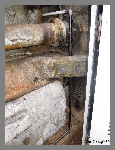 |
Using new 1/2" black pipe, we neatly plumbed over the front of the engine, through the block of our M&S 538 prime mover and down to the bottom of the crankcase. The new pipe will be primed and painted with "Industrial Grey" enamel so it will look like original equipment. When we removed the plug from the crankcase, a small amount of oil was lost when we switched the fittings. We will remove the handles on the ball valves to prevent the accidental opening of the pipes and replace them when needed. | 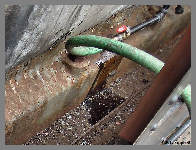 |
April 2017
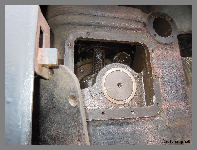 |
We never got a chance to test our General Electric CP-26 compressor last year so we spent a little time making sure it would be ready this year. After removing the two crankcase inspection covers, we were pleased to see that everything was well oiled and there were no signs of water. Using a 2-1/2" socket and a 3/4" ratchet with a long extension, we were able to easily rotate the pinion gear and get fresh oil all over the bull gear. | 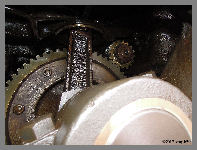 |
| The weather continued to cooperate the rest of the week, so Jim finished priming and painting both sides of the battery compartment insulation boards. Over forty 2-1/2" drain holes were cut to match the holes in the steel compartment floor to allow water to drain from the bottom. |
May 2017
| On May 3rd, we were confident that freezing weather was behind us so we filled the cooling system. We ran 175 feet of hose from the ArtCraft Train depot to the locomotive and in less than an hour had filled the system, and again had no leaks. While we had all that hose out, Rick B. used his pressure washer to remove some of winters grime. |
June 2017
| With confidence that the compressor system was good to go, we went back into the cab to give it a try. Meter readings at the battery switch showed we had 88.6 volts of power, more than enough to roll the motor over. With an easy push on the compressor relay switch, the motor after resting silent for 18 years came to life! With another system checked off our list as "good," we again connected our "pre-lube" oil pump so we could bar the engine over. This was to allow us to clean the hundreds of brass commutator segments on the three generators. The cleaner the segments are, the better the generator performs. With the prime mover oiled, we were able to rotate the crankshaft a little bit at a time to polish them with red "Scotch-Brite™" pads. |
| More charging of the other batteries is still required. Bob M. added a new decal to the electrical cabinet doors to remind us the open the "Battery Switch" before leaving at the end of the day. |
July 2017
| Frustrated with our attempts to get the prime mover started, we again turned to the BSOR for some help. On July 3rd, the railroad was on a holiday schedule so Pat Connors graciously offered to bring down ALCO RS-18u #1847 to give us a jump. With 12 batteries on board, we quickly had two 20 foot 3/0 jumper cables connected from knife switch in #1847 to the switch in #43 and a positive terminal at 64 volts. |
| We had already pre-lubed the engine, so as soon as we had fuel pump pressure I pushed the start button and the engine came to life! The prime mover started like it had been run yesterday, very little smoke, no leaks and it idled smooth. With the engine running we hoped to be able to charge all of the batteries at once. A big Thank you to Patrick Jr. who shot this video and of course to Pat Sr. for taking the time to come into work on a day off! |
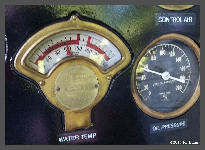 |
With the engine smoothly "ka-chunking" at around 400rpm, we adjusted the voltage regulator as low as it would go to 108.4 volts. This put an initial current of over 50 amps into all 12 batteries but within 1/2 hour it dropped to around 35 amps. Turning the big DC compressor on immediately put the meter over 50 amps again. When we had 100 psi in the system, we cycled the brakes, bell and horn. | 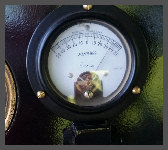 |
| We were back on the 10th to continue charging three batteries at a time with our 24 volt charger. We also investigated why the dropping resistor for the voltage regulator was getting very, very hot. As shown in the link above, previous "maintenance" on the wiring left much to be desired, Ha! We started correcting all those minor electrical wiring issues. We also found that after the compressor was run for the first time in over 17 years, we had air leaking from the compressor crankcase breather pipe, another "small" issue to deal with. |
| We again wish to express our sincere thanks to the Buffalo Southern Railroad management and to Chief Mechanical Officer Pat Connors for all their help as we move toward our goal of getting #43 back onto the mainline. |
| On the 17th we used "silver solder" to make up 4 new 10ga wire leads to the dropping resistor and thoroughly cleaned all the connections. Silver solder melts at a lot higher temperature than common solder so the heat from the resistor would no longer be a problem. A couple of other new leads were made to finish all the connections to the voltage regulator. While Bob Martin and Jim Long were preparing the interior of the engine compartment for painting, Rick Burns started working on the compressor issue. |
August 2017
By Scott Hawbaker
September 2017
| While Rick and I fought with the compressor valves, Jim L. & Bob M. continued the messy dirty job of wire brushing and priming the interior of the engine compartment. The sides are not too bad but the ceiling overhead is not easy. What they have completed looks great! |
| On the 12th and the 19th of September we slowly removed the last four valve caps, cleaned and replaced the valves and reinstalled the caps. Even with the come-along, we still had to reset the wrench every 1/4 of a turn due to the limited space and every cap fought us all the way. Once we cleaned the threads in the cylinder and on the cap we were able to turn them back in with just two fingers, Ha! After the last valve was finished and replaced, we aired the system up to 80 pounds in no time at all. We were thrilled that no more air was leaking from the compressor and the system stayed charged. |
October 2017
| But.... it was 45 degrees that morning and our 77 year old engine gave us a hard time starting. It took us three tries and on the third we "pumped the pedal." Remember doing that when we had a carburetor on our cars? Ha! As I held the start button, Rick Burns lifted the governor control rod to add extra diesel fuel, and then with a lot of smoke the prime mover came to life! In less than a minute the engine was idling smoothly and we were ready to hopefully make our first move. |
| However, we were not disappointed. Everything else worked as designed. The voltage regulator kept a steady 107.6 volts going to the eleven batteries and electrical system and the compressor shut off automatically at 90psi. We took a hot oil sample to send in for analysis. No leaks were found and the water temp stayed under 150 degrees. After we burned up 13 gallons of fuel we shut her down. It was time to drain the water from the cooling system for winter. |
November 2017
| November to date has been a much colder month than October with a record setting rain on more than one day. Since it was too cold and damp to paint anything on the 13th, we made a list of projects and supplies that we can work on and gather over the winter months. Our big "36th Annual Greater Buffalo Train & Toy Show" was held on the 18th and 19th, the weekend before Thanksgiving. |
December 2017
| On December 9th and 10th, the Buffalo Cattaraugus & Jamestown Scenic Railway Was running their Santa Express Train Rides behind Scott Symans "Viscose #6" 0-4-0 Steam Engine. Hamburg had received almost 6" of fresh snow by the morning and it continued all day. Bill Stone was out with his camera to photograph the Santa trips and caught #43 covered with fresh powder. | 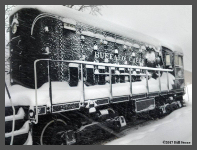 |
| The WNYRHS greatly appreiciates all the generous donations to this project to date. However, we could still use your help! All Donations to the WNYRHS, Inc. are Tax-Deductable! If you would like to mail in a donation, send it to WNYRHS Inc., PO Box 416, Buffalo, New York 14231-0416 or |
| Click the PayPal Button to make a Secure Electronic Donation. THANK YOU! |
Web Site Hosting by TRAIN WEB
The WNYRHS, Inc. P.O. Box 416, Buffalo, NY. 14231-0416 is an independent organization and has no affiliation with any other local or national group.
The Society is a fully qualified organization under 501 (C) (3) of the Internal Revenue Code and all donations to the Society are tax deductible.
©Copyright 1999 , WNYRHS Inc. all rights reserved